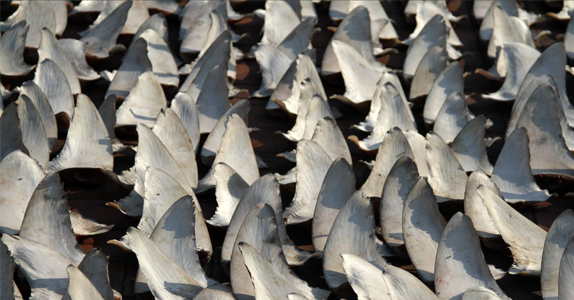
People & Business
86 Shark Species at Risk of Extinction
July 19, 2022 – Sarasota
More than 70 percent of species that end up in the global shark fin trade are at risk of extinction — and sharks living closer to our coastlines might be of greatest conservation concern, according to new research.
A team of international scientists from the U.S. and China sampled 9,820 fin trimmings from markets in Hong Kong — one of the largest shark fin trade hubs in the world. With a little DNA detective work, they unraveled the mystery of what fin belonged to what species. In total, they found 86 different species of sharks and their relatives the rays and chimeras. Sixty-one of those, more than two-thirds, are threatened with extinction. The research were recently published in Conservation Letters.
“Overfishing is most likely the immediate cause of the declining trends we are seeing in shark and ray populations around the world. The fact that we are finding so many species threatened with extinction in the global shark fin trade is a warning sign telling us that international trade might be a main driver of unsustainable fishing,” said Diego Cardeñosa Florida International University (FIU) postdoctoral researcher and the study’s lead author.
The International Union for the Conservation of Nature (IUCN) Red List of Threatened Species assessed sharks and their relatives in 2021 and found about one third of all species were threatened. Results of this new study indicate species in this trade are much more likely to be in threatened categories.
For nearly a decade, Demian Chapman — Director of the Sharks & Rays Conservation Research Program at Mote Marine Laboratory & Aquarium and Adjunct Professor at FIU — has led the collaborative team, that includes Cardeñosa, to track and monitor the global shark fin trade. To date, they’ve conducted DNA testing on about 10,000 small scraps taken from processed imported fins, sold in markets in Hong Kong and South China. The project is in collaboration with BLOOM Association Hong Kong and Kadoorie Farm & Botanic Garden. The team’s goal is to better understand what species are in the trade and how common they are. By tracking this over time, they will be able to inform decision-makers about how well various management measures are working.
The study found the common species that end up in the fin trade are open-ocean, or pelagic, sharks, such as blue and silky sharks. However, the greatest number of species in the trade — and many of the most common — live in coastal areas, including blacktip, dusky, spinner, and sandbar sharks. The researchers warn without management many of coastal species could become extinct.
“A few nations are protecting or sustainably fishing sharks and their relatives, but the majority are not for a variety of reasons,” said Chapman. “Quite a few of the coastal sharks we found in the trade — such as smalltail, broadfin, whitecheek and various hound shark, river shark and small hammerhead species — are listed as Endangered or Critically Endangered and yet there are no regulations protecting them anywhere in their range. Unless the relevant governments respond with management soon, we are likely to experience a wave of extinctions among coastal sharks and rays.”
Three coastal species are already thought to be extinct — all found in nations that did not regulate shark fishing.
One way to encourage better species management within nations is to list them under the Convention on International Trade in Endangered Species of Wild Fauna and Flora (CITES) — an international agreement seeking to protect animals and plants from overexploitation driven by international trade. The 19th meeting of the Conference of the Parties (CoP19) to CITES will take place in November. This study will provide key evidence for the body’s deliberations by bringing the plight of costal sharks to the attention of governments and showing only a small percentage of the overall trade in shark fins is currently regulated under the Convention.
“The upcoming CITES CoP19 Governments have tabled proposals that would bring the vast majority of sharks traded for their fins under the Convention’s sustainability controls, action that has been informed by this study’s findings. We’re encouraged to see CITES Governments match their level of ambition to the level of threat seen for sharks and rays globally, with CITES listings a strong driver for better domestic management of shark fisheries” said Luke Warwick, Director of Shark and Ray Conservation at the Wildlife Conservation Society.
If these proposals are adopted, nations would be obliged to ensure that any export of listed species is legal, traceable and sustainable.
“There is a rage of management actions that nations can take to get coastal shark fishing under control and avert this extinction crisis,” said Chapman. “From changing fishing gear, to creating protected areas, to limiting catch, the solutions are out there.”
“Since our Founding Director, Dr. Eugenie Clark—the Shark Lady—began her work documenting shark populations in southwest Florida and around the world over 65 years ago, the core of Mote has been to push the frontiers of science in support of evidence-based, sustainable use of our shared ocean resources,” said Mote President & CEO Dr. Michael P. Crosby. “We plan to continue this study’s vital work monitoring shark species commonly found in the trade, through the collaboration of innovative science, community-engagement and resource management that together are critical to preventing extinction of these species.”
“Our results highlight high levels of international trade and clear management gaps for coastal species. Many are in the highest extinction risk categories. The next category is extinction. We can’t allow this to happen,” Cardeñosa said.
This research was supported by the Shark Conservation Fund, the Pew Charitable Trusts, the Pew Fellowship Program, and the Roe Foundation.



You must be logged in to post a comment Login